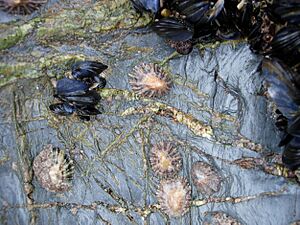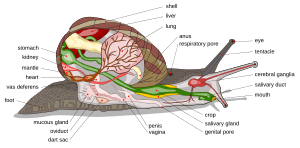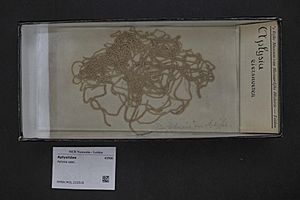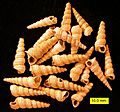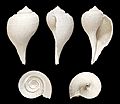Gastropoda facts for kids
Quick facts for kids Gastropod |
|
|---|---|
 |
|
| Cypraea chinensis | |
| Scientific classification | |
| Kingdom: | |
| Phylum: | |
| Class: |
Gastropoda
Cuvier, 1797
|
| Subclasses | |
|
|
Gastropods are a huge group of molluscs, also known as univalves. They are the largest and most successful class of molluscs. There are between 60,000 and 75,000 known living species of gastropods. Most of them live in the sea, but many also live in freshwater or on land. Their history goes back to the later Cambrian period.
You might know some gastropods already! Slugs and snails are gastropods. So are abalones, limpets, cowries, conches, top shells, whelks, and sea slugs. Gastropods first appeared as predators on the sea floor. Over time, they evolved to live in many different habitats. Many types of gastropods we see today developed during the Mesozoic era. They used the huge amount of food available on the sea floor.
Contents
Amazing Gastropod Anatomy
Gastropods have a special body twist called torsion. This means their body organs rotate 180 degrees during development. Because of this twist, their anus (where waste leaves the body) ends up near their head! This twist is different from how their shell coils. Torsion happens in all gastropods. However, some sea slugs have partly untwisted over time.
This twisting process helps the gastropod pull its head into its shell first. This might be a way to protect themselves from danger. When they retract, their head is safe right away.
Gastropods usually have a clear head with two or four sensory tentacles. These tentacles often have eyes. They also have a large, muscular foot on their underside. This foot gives them their name: "gaster" means stomach and "pous" means foot in Greek. The front part of the foot is called the propodium. It helps the snail push away dirt as it moves. The baby shell of a gastropod is called a protoconch.
A key feature of gastropods is that their main organs are not perfectly even on both sides. For example, the anus is usually on one side. Also, their gills, osphradium (smell organs), and heart parts are often more developed on one side. They also have only one opening for their reproductive organs. This opening is on the same side as the anus.
Their Unique Shell
Most gastropods with shells have a single, coiled, or spiral shell. This is true at least when they are young. This coiled shell usually opens on the right side. You can see this if you hold the shell with its tip pointing up. Many species have an operculum. This is like a trapdoor that closes the shell opening. It is often made of a tough, horn-like material. In some molluscs, it is made of a hard, chalky substance. Land slugs do not have a large shell. Their shell is either very small or completely missing. This makes their body smooth and streamlined.
Colorful Bodies
Some sea slugs are very bright and colorful. This bright color can be a warning sign. It tells other animals that they are poisonous or have stinging cells. Other sea slugs use their colors to camouflage themselves. They blend in with the brightly colored hydroids, sponges, and seaweeds where they live.
Some nudibranchs have special growths on their sides called cerata. These growths contain parts of their digestive system.
Senses and Nerves
Gastropods have several senses. They have organs for smell, eyes, balance organs (statocysts), and touch sensors (mechanoreceptors). However, gastropods cannot hear.
For land snails and slugs, their sense of smell is very important. Their smell organs are on the tips of their four tentacles. Marine sea slugs called opisthobranchs have special smell organs called rhinophores.
Most gastropods have simple eyes. These are usually just eye spots at the tip or base of their tentacles. These "eyes" can range from simple ocelli that only tell light from dark. Some have more complex pit eyes, or even lens eyes. Land snails and slugs are mostly active at night. So, their vision is not their most important sense.
The nervous system of gastropods includes a peripheral nervous system and a central nervous system. The central nervous system has groups of nerve cells called ganglia. These ganglia are connected by nerve cells.
How They Eat
A gastropod's radula is like a rough tongue with tiny teeth. It is shaped to help the species eat its specific food. The simplest gastropods are limpets and abalones. They are herbivores, meaning they eat plants. They use their hard radula to scrape seaweed off rocks.
Many marine gastropods dig into the sand. They have a siphon that sticks out from their mantle edge. Sometimes their shell has a special canal for this siphon. The siphon helps them pull water into their mantle cavity and over their gills. They mainly use the siphon to "taste" the water. This helps them find food or prey from far away. Gastropods with siphons are often predators or scavengers.
How They Breathe
Almost all marine gastropods breathe using a gill. But many freshwater species and most land species have a lung-like organ. This organ is called a pallial lung. The substance that carries oxygen in most gastropods is hemocyanin. However, one family of freshwater snails, the Planorbidae, uses hemoglobin to carry oxygen.
Some sea slugs, called nudibranchs, have their gills arranged like a rosette of feathery plumes on their backs. This is how they got their name. Some nudibranchs have smooth or bumpy backs with no visible gills. They likely breathe directly through their skin.
Blood and Circulation
Gastropods have an open circulatory system. This means their blood-like fluid, called hemolymph, flows freely around their organs. Hemocyanin is the pigment in their hemolymph that carries oxygen.
How They Get Rid of Waste
The main organs for getting rid of waste in gastropods are nephridia. These organs produce either ammonia or uric acid as waste. The nephridium also helps freshwater and land species control their water balance. Some species also have other organs for waste removal. These include pericardial glands and digestive glands that open into the stomach.
Gastropod Life Cycle
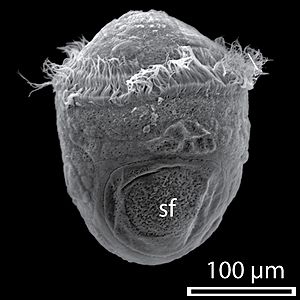
The life cycle of gastropods includes several stages:
- Egg Laying: Gastropods lay eggs. The eggs can look very different depending on the species.
- Embryonic Development: This is when the baby gastropod grows inside the egg.
- Larval Stages: Some gastropods have tiny, free-swimming larvae. These can be trochophore or veliger larvae.
- Resting Periods: Some gastropods go into a deep sleep. This can be estivation (during hot, dry times) or hibernation (during cold times).
- Growth: Gastropods grow from tiny larvae or hatchlings into adults.
- Courtship and Mating: Gastropods find partners and mate. Fertilization can happen inside the body or outside, depending on the species. External fertilization is common in marine gastropods.
What Gastropods Eat
What a gastropod eats depends on its group. Marine gastropods can be herbivores (eating plants) or detritus feeders (eating decaying matter). Some are predatory carnivores (hunting other animals). Others are scavengers (eating dead animals) or parasites (living on or in other organisms). A few are ciliary feeders, meaning they filter tiny particles from the water. In these, the radula is very small or missing.
Land-dwelling species can chew on leaves, bark, fruit, and dead animals. Marine species can scrape algae off rocks on the sea floor. Some gastropods, like the Archaeogastropda, have rows of thin teeth. In some species that have become endoparasites, like Thyonicola dogieli, many typical gastropod features are greatly reduced.
Some sea slugs are herbivores, while others are carnivores. The carnivorous ones are very specialized in what they eat. Many gastropods have favorite foods. They are often found living close to the species they eat.
Examples of predatory carnivorous gastropods include Cone shells, Testacella, Daudebardia, and the Ghost slug.
How Gastropods Are Classified
The way gastropods are classified is always being updated. Scientists use new information, like DNA sequencing, to group them. This means the classification might be different depending on which scientist you ask.
Modern classification tries to group animals into "monophyletic" groups. This means each group should include all the descendants from one common ancestor. It can be hard to do this and still have a practical way to classify them. Scientists often classify animals by what they look like (their morphology). But sometimes, what they look like doesn't match their DNA. This can happen because of Convergent evolution. This is when different species develop similar features because they live in similar environments.
Here is a traditional way gastropods used to be classified into four main groups:
- Prosobranchia: These have gills located in front of their heart.
- Opisthobranchia: These have gills located to the right and behind their heart.
- Gymnomorpha: These gastropods have no shell.
- Pulmonata: These gastropods have lungs instead of gills.
Gastropods Through Time
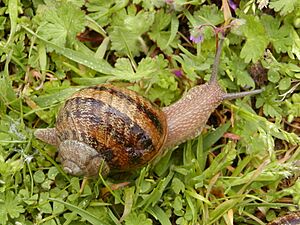
The first gastropods lived only in the sea. The earliest ones appeared in the Upper Cambrian period. By the Ordovician period, gastropods were a diverse group living in different water habitats. Often, fossil gastropods from the early Palaeozoic era are not well preserved. This makes them hard to identify. Still, the Silurian genus Poleumita has fifteen known species. Gastropod fossils are less common than bivalve fossils during the Palaeozoic era.
Most gastropods from that time belong to very old groups. A few of these groups are still alive today. By the Carboniferous period, many shapes seen in living gastropods can be found in the fossil record. But even if they look similar, most of these older forms are not directly related to today's gastropods. The ancestors of many living gastropods evolved during the Mesozoic era. One of the earliest known land-dwelling gastropods is Maturipupa. It is found in the Coal Measures of the Carboniferous period in Europe. It is not certain if the common fossil Bellerophon, from Carboniferous limestones in Europe, is a gastropod or not.

Relatives of modern land snails are rare before the Cretaceous period. The familiar Helix first appeared in that period.
In rocks from the Mesozoic era, gastropods are more common as fossils. Their shells are often well preserved. Their fossils are found in both freshwater and marine rocks. For example, the Purbeck Marble from the Jurassic period and the Sussex Marble from the early Cretaceous are limestones. They are found in southern England and contain many remains of the pond snail Viviparus.
Rocks from the Cainozoic era have a very large number of gastropod fossils. Many of these fossils are very similar to modern living forms. The variety of gastropods greatly increased at the start of this era, along with bivalves.
Gastropods are one of the groups that show how animal life changed. This was due to the advance and retreat of the Ice Sheets during the Pleistocene epoch.
Explore More Gastropods
These pages show the many different types of gastropods:
Images for kids
-
Cornu aspersum (formerly Helix aspersa): a European land snail found worldwide.
-
The Devonian gastropod Platyceras from Wisconsin.
-
Fossil gastropod and attached bivalves on a Jurassic limestone in southern Israel.
-
Trochonema sp., an early gastropod from the Middle Ordovician of the Galena Group of Minnesota.
-
An unidentified land gastropod and insects trapped in Cretaceous amber.
See also
 In Spanish: Gasterópodos para niños
In Spanish: Gasterópodos para niños


